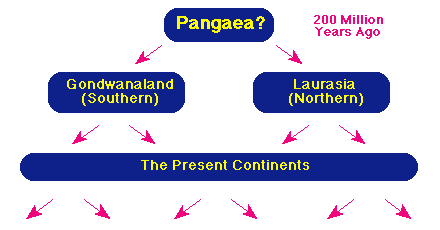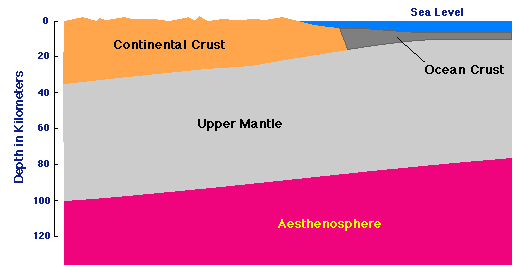It is now uniformly agreed that the crustal plates of the Earth are in horizontal motion. This is called continental drift colloquially, and plate tectonics (see also this summary) in technically more precise language. This is newly won knowledge. Although the idea has been around for almost a century, it was not generally accepted (indeed, was often considered crackpot) until the last few decades.
The following animation illustrates the drift of the continental plates over the last 750 million years (Source). Here is a better animation (but it is a 1.44 MB animated GIF file).
 |
| The separation of the continents by plate tectonics |
The present continents separated from two supercontinents called Laurasia and Gondwanaland through this process of plate tectonics. The two supercontinents may have once been united in a single supercontinent called Pangaea, though this is less certain.
 |
| The lithosphere and the aesthenosphere |
The crust is thin, varying from a few tens of kilometers thick beneath the continents to to less than 10 km thick beneath the many of the oceans. The crust and upper mantle together constitute the lithosphere, which is typically 50-100 km thick and is broken into large plates (not illustrated). These plates sit on the aesthenosphere.
The aesthenosphere is kept plastic (deformable) largely through heat generated by radioactive decay. The material that is decaying is primarily radioactive isotopes of light elements like aluminum and magnesium. This heat source is small on an absolute scale (the corresponding heat flow at the surface out of the Earth is only about 1/6000 of the Solar energy falling on the surface). Nevertheless, because of the insulating properties of the Earth's rocks this is sufficient to keep the aesthenosphere plastic in consistency.
 |
| The plates of the lithosphere and convection in the aesthenosphere |
Of course, the timescale for convection in the pan is seconds and for plate tectonics is 10-100 million years, but the principles are similar. Thus, we see that differentiation is crucial to plate tectonics on the Earth, because it is responsible for producing an interior that can support tectonic motion.